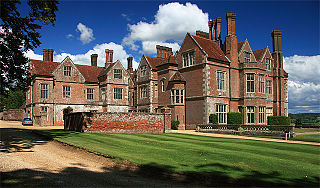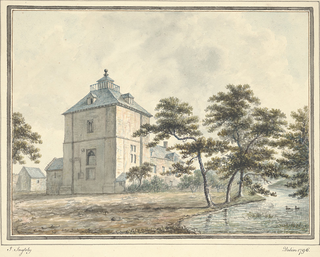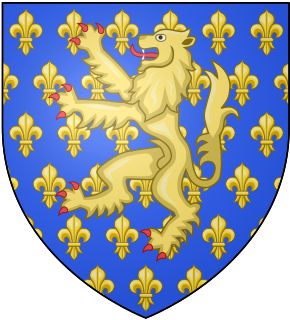
Breamore House is an Elizabethan manor house noted for its fine collection of paintings and furniture and situated NW of Breamore village, north of Fordingbridge, Hampshire, England. Though it remains in private hands, it is open to visitors from April to October.

There have been two baronetcies created for members of the Hanmer family of Flintshire, Wales, one in the Baronetage of England and one in the Baronetage of Great Britain. Only one creation is extant as of 2008. The third Baronet of the second creation was elevated to the peerage as Baron Hanmer in 1872, a title which became extinct in 1881. The family name derived from the manor of Hanmer in the Diocese of St. Asaph.
Nineteen baronetcies have been created for persons with the surname Hamilton, eight in the Baronetage of Nova Scotia, one in the Baronetage of England, five in the Baronetage of Ireland, one in the Baronetage of Great Britain and four in the Baronetage of the United Kingdom. As of 2008 two creations are extant, two are dormant, two are either extinct or dormant and twelve extinct.
There have been two baronetcies created for members of the Blackett family, both in the Baronetage of England. One creation is extant as of 2013. The Blackett family can be traced back to the Blacketts/Blakheveds of Woodcroft, County Durham, some of whom became highly successful in the lead and coal mining industries in Northumberland and County Durham.
There have been six baronetcies created for persons with the surname Brooke, one in the Baronetage of England, one in the Baronetage of Ireland and four in the Baronetage of the United Kingdom. As of 2015 four of the creations are extant, though one has been subsumed into a peerage.
There have been three baronetcies created for persons with the surname Wilmot, one in the Baronetage of Ireland and two in the Baronetage of Great Britain. One creation is extant as of 2008.
There have been four baronetcies created for persons with the surname Crofton, two in the Baronetage of Ireland and two in the Baronetage of the United Kingdom. As of 2014 three creations are extant.
There have been two baronetcies created for persons with the surname Curtis, one in the Baronetage of Great Britain and one in the Baronetage of the United Kingdom. One creation is extant as of 2007.

The Every Baronetcy, of Egginton in the County of Derby, is a title in the Baronetage of England. It was created on 26 May 1641 for Simon Every, Member of Parliament for Leicester in 1640 and a supporter of the Royalist cause in the Civil War. Born into the Every family of Dorset and Somerset, and a cousin to the Brice family of Somerset, he married Anne, daughter and co-heir of Sir Henry Leigh, of Egginton, Derbyshire. After his marriage, Every settled at Egginton.

The Frederick Baronetcy, of Burwood House in the County of Surrey, is a title in the Baronetage of Great Britain. It was created on 10 June 1723 for John Frederick of Burwood House in the southern half of Walton-on-Thames which later became Hersham.

The Malet Baronetcy, of Wilbury in the County of Wiltshire, is a title in the Baronetage of Great Britain. It was created on 24 February 1791 for Charles Malet, for diplomatic services in India. The second Baronet was Minister to the German Confederation from 1852 to 1866. The fourth Baronet was Ambassador to Germany between 1884 and 1895. The seventh baronet was a Colonel in the 8th King's Royal Irish Hussars, who served in the Boer War and the First World War and was awarded a DSO and OBE.The eighth Baronet was also a Colonel in the 8th King's Royal Irish Hussars and High Sheriff of Somerset from 1966 to 1967.
Peregrine Hoby, was an English landowner and member of parliament who sat in the House of Commons at various times between 1640 and 1679.

There have been three baronetcies created for persons with the surname Style, one in the Baronetage of Ireland and two in the Baronetage of England. Two of the creations were in favour of the same person. As of 2014 one creation is extant.

There have been two baronetcies created for persons with the surname Leighton, one in the Baronetage of England and one in the Baronetage of the United Kingdom. One creation is extant as of 2010.

There have been four baronetcies created for members of the ancient House of Beaumont, all in the Baronetage of England. All four creations are extinct or dormant.

There have been six baronetcies created for members of the Corbet family, four in the Baronetage of England, one in the Baronetage of Great Britain and one in the Baronetage of the United Kingdom. All creations are extinct. The recipients were descendants of the ancient Norman family of Corbet which held substantial estates in Shropshire including Wattlesborough, Caus Castle, Moreton Corbet Castle and Acton Reynald Hall.
The Sheriff of County Dublin was the Sovereign's judicial representative in County Dublin. Initially, an office for a lifetime, assigned by the Sovereign, the Sheriff became an annual appointment following the Provisions of Oxford in 1258. We know that David de Offington was Sheriff in 1282, apparently the first recorded holder of the office. Besides his judicial importance, the sheriff had ceremonial and administrative functions and executed High Court Writs.

Sir Charles Hulse, 4th Baronet was a British Member of Parliament.
Charles Westrow Hulse was an English first-class cricketer and British Army officer.
Major-General Richard Hulse was a senior British Army officer who saw action in the Napoleonic Wars.










